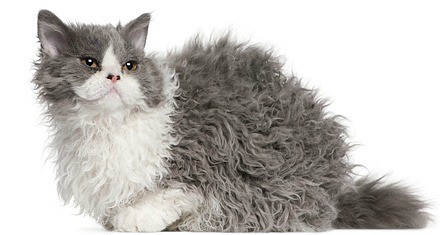Type the name of the breed you're looking for below
[wpdreams_ajaxsearchlite] Don't see the breed your're looking for? Click here and let us know!
Breed Characteristics
1 paw - breed exhibits the least amount of this characteristic
5 paws - breed exhibits most amount of this characteristic
Selkirk Rex
| Origin And History | The Selkirk is the newest Rex breed to be recognized by the U.S. cat associations and has been around only a short time compared with the Devon Rex and the Cornish Rex. The Selkirk's development and promotion were due primarily to the efforts of breeder Jeri Newman of Livington, Montana, although other dedicated breeders have lent a hand in furthering the breed. Newman, a Persian breeder for many years, had always been fascinated by cat genetics and asked friends and family to be on the lookout for any cat that was 'out of the ordinary'. In 1987 a woman who had bought one of Newman's Persians noticed an unusual, curly kitten at the animal shelter where she worked and took the kitten to Newman. Newman named the kitten Miss DePesto for her tendency to pester Newman for attention. Entranced by Miss DePesto's personality and curly coat, Newman bred her to a Persian male. This mating subsequently produced a litter of six, three of whom had the distinctive curls. Newman went on to combine the qualities of the British Shorthair, American Shorthair, and Exotic Shorthair into the Selkirk bloodline and to show and promote the breed in the associations. At first progress was slow, but with the help of Newman's small clan of breeders the Selkirk gained recognition. |
| Personality | Selkirks are fun-loving, mellow cats with a generous measure of love and affection for their human companions. Very people-oriented, they stay playful and kittenish even as adults. They're very social and don't do well in isolation. |
Physical Attributes
| Appearance | The Devon and the Cornish Rex have coats governed by recessive genes. In order for a cat to display a recessive characteristic, the kitten must inherit the gene from both parents. The Selkirk's gene is dominant, meaning that only one parent need possess the gene for the curly coat to be expressed in the offspring. A cat that has received the Rex gene from one parent will produce Rex kittens at an approximate ratio of one Rex to one straight-coated kitten. The kittens born with straight coats do not carry the Rex gene at all. A cat receiving the gene for the Rex coat from both parents (homozygous) is a great boon for breeders, since the cat can be bred with an outcrossing and all the resulting kittens will have the Rex coat. Also, the fur of homozygous cats is curlier and softer than the coats of cats that possess only one copy of the gene. The coat goes through several stages as the cat develops. A Selkirk is curly at birth, then loses his curliness and slowly acquires it again at 8 to 10 months of age. The coat doesn't fully develop until the cat is two years old. Climate, season, and hormones (particularly in the females) can also influence the coat curl. Unlike the Devon Rex and the Cornish Rex, the Selkirk Rex comes in both long and short hair. |
| Health | There are no known health problems specific to the Selkirk Rex breed. They are a robust breed. Breeding towards proper head structure is necessary to prevent kinking of the tear ducts, resulting in tear run down the front of the face, or muzzle creases that can result in dermatitis on the face. Like other Rex breeds, irritation of the inside of the ear by curly fur can occur, increasing the production of ear wax. Homozygous cats (with two copies of the dominant Selkirk Rex gene) may have a tendency towards excessive greasiness of the coat, requiring increased frequency of bathing. Other health problems may be inherited from the outcross breeds used, including Polycystic Kidney Disease from Persians and Hypertrophic Cardiomyopathy from British Shorthairs. Responsible breeders screen their breeding cats for these diseases to minimize their impact on the breed. |



